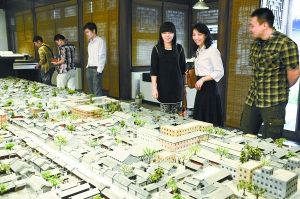|
1st Beijing hutong museum opens
If a city has its soul, it could be found in its architecture. And Beijing's soul exists along each hutong.
Although the number of these traditional Chinese alleyways is decreasing as the wrecking ball swings with different excuses of transformation, hutongs still stand in the downtown. Now the city's first public hutong museum has opened on Shijia Hutong, one of the most historic of the hutongs. From Friday, the museum will give visitors the lowdown on how hutongs and the traditional siheyuan courtyard homes that line them have changed over the years. Shijia Hutong Museum is dedicated to promoting Beijing hutong culture, enriching the intellectual life of local residents, and sustaining a site that evolves constantly with time and presents the living history of hutongs, according to Chen Dapeng, secretary of Chaoyangmen sub-district. "The exhibition is a footnote to chapters of beauty and the essence of Shijia Hutong, and hutongs in general in Beijing, as well as the traditional Beijing hutong lifestyle," added Wang Lanshun, who came up with the idea for Shijia Hutong Museum. "The most precious thing is that the museum is embedded in a living hutong and quadrangle courtyards in downtown Beijing," Wang said. "So when visitors step out of the museum, they will feel they are in another museum." Shijia Hutong Museum is in a renovated siheyuan that was the former home of celebrated Chinese writer Ling Shuhua. The reconstruction work applied old bricks and tiles, "all of them collected from hutongs around Beijing and the city's heritage sectors," Chen explained. The origin of the name "Shijia" cannot be verified but it is said that it was named for the prominent Ming Dynasty "Shi" family, while others claim that it is a reference to Ming Dynasty Chancellor Shi Kefa. Fittingly for a site now dedicated to imparting knowledge, the alley has a close relation to education. In 1908, the U.S. Congress passed an act allowing Chinese students to study in the United States via a scholarship program. Under an agreement between both sides, "Tsinghua College" was then founded. From 1909, China began sending 100 students to study in the United States each year. The same year, the Qing-Dynasty Ministry of Foreign Affairs asked the Emperor for permission to establish an administrative office to settle all affairs concerning overseas students in the United States. The office was located in Shijia Hutong. In 1909, 1910 and 1911, three selectional exams took place on the alleyway, on the spot where today's Shijia Hutong Elementary School is located. Hu Shi, a noted Chinese academic, was among the second group of exchange students who won the right to study in America. Shijia Hutong Museum also charts the turbulent history of the street on which it stands and Beijing's hutong network overall. |
| Copyright © China.org.cn. All Rights Reserved 京ICP证 040089号 京公网安备110108006329号 网络传播视听节目许可证号:0105123 京公网安备110108006329号 京网文[2011]0252-085号 |

 0
0 








Go to Forum >>0 Comment(s)